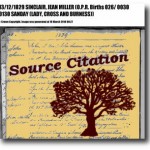Articles
How to Cite Family Tree Information Sources
March 2, 2012 by ramona
Filed under Articles, Genealogy Standards & Guidelines, Introduction to Genealogy, Latest News, Lesson 1 Articles
As a family tree enthusiast, you are probably aware that your genealogical information comes from multiple places such as government agencies, Old Parish Records, monumental inscriptions, online genealogy sites, books and newspapers. No matter where you found the information about your ancestors it is simply good practice to cite your sources. The basics of citing a source are simple.
Citing a Genealogy Source Consists of Naming:
- Who created the source (publisher, historical society, government agency)
- What the source was titled (John O’ Groat’s Journal)
- When the information was created (copyright or year of publication)
- Where the information was created (State, County, and/or name of publisher)
- How you found it (name of repository or archive)
- Why it is a good source (primary, secondary or tertiary source)
Citing sources is particularly important if you plan to publish your family tree to the internet and it helps all of us involved in family tree research to sort out the reliable information from assumptions and guesswork.
Citing Sources for the Genealogy Beginner Citing sources can also be time consuming and confusing if you are not familiar with how to cite properly a source of genealogical information. For starters, here are some general helps and guidelines to citing a source.
Genealogy Citation Guidelines:
- <angle brackets> are for internet addresses <https://www.genealogybeginner.com/>
- [brackets] are for descriptive information
- Information about publishers should be in
- (parentheses)
Always cite exactly what you have found along with where you found it If you have doubts either leave it out or note is as a supposition.
For example in the case of a Monumental Inscription:
PETER SINCLAIR, CATHERINE CALDER Erected By Peter Sinclair In Memory Of His Wife Catherine Calder Who Died At Greentoft, 21st March 1905, Aged 72 Years. Also Peter Sinclair, Born At Cleat, Sanday, 12th June 1830, Died At Greentoft, Eday, 3rd January 1917
Citation:
Orkney Family History Society , “Orkney Graveyard Search for: Sinclair in Eday & Pharay, Old Kirkyard, St Marys, Eday Orkney” (Orkney Family History Society ) [Ray Millar ] <http://www.orkneyfhs.co.uk/mis/minscriptions.php?opt=gyard&gref=151&surname=Sinclair> Report date: 04/03/12
note: Eday, Orkney, Scotland: Eday Old Kirkyard, Orkney, Scotland Plot: 329
It also helps to become familiar with the abbreviations used in citing your family tree information sources along with the standard formats used. Standard
Abbreviations for Genealogical Citations

Standard Format for Online Genealogical Citations
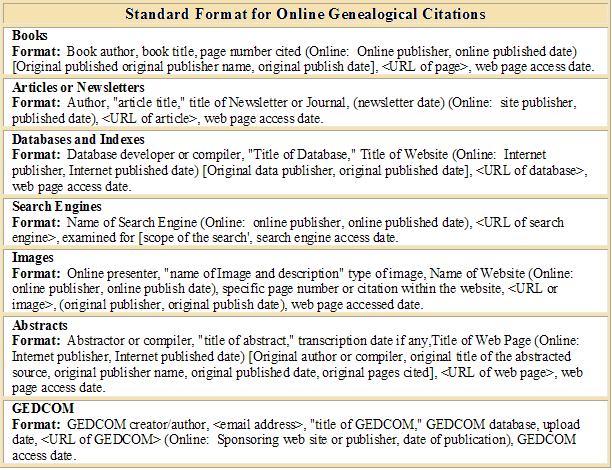
Citing your sources will give you the confidence to publish your family tree knowing that all of your hard work is beyond reproach. You can learn more about the importance of citing your family tree research and genealogy best practices in Genealogy Beginner’s Lesson 1: The Big Five Genealogy standards and guidelines: what you need to know first
Image Credit: Ramona Hartley
Genealogy News: Accessible Archives
February 29, 2012 by ramona
Filed under Articles, Latest News
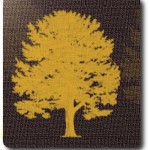 Accessible Archives has been a well-kept secret for far too long. The company founded in 1990 has made an impressive amount of archived information (at one time only offered through microfilm) available through computer technology.
Accessible Archives has been a well-kept secret for far too long. The company founded in 1990 has made an impressive amount of archived information (at one time only offered through microfilm) available through computer technology.
Accessible Archives has excellent search capacity that allows family history buffs to pinpoint very specific information that is then presented in digital format or through direct link.
Collections for Family History
This invaluable resource for genealogists contains mainly “PRIMARY SOURCE” materials! Filled with mostly US based content, Accessible Archives has a huge collection of newspapers and books from the 1700’s to 1800’s.
Some of the items in their collection that have the greatest genealogical value include:
- African American Newspapers
- Frederick Douglass’ Paper
- Freedom’s Journal
- Provincial Freeman (Canadian Publication)
- American County Histories to 1900
- Delaware and Maryland County Histories
Maine County Histories
New York County Histories
Vermont County Histories
- Delaware and Maryland County Histories
- The Civil War Collection
- Part I: A Newspaper Perspective
- Part II: The Soldiers’ Perspective
- Part III: The Generals’ Perspective
- Part IV: A Midwestern Perspective
- Part V: Iowa’s Perspective
- Part VI: Northeast Regimental Histories
Access for Genealogists
Access is available on a two-tier platform that includes institutions and individuals. For individual access, there is a yearly membership fee of $59.95 payable via internet by credit card, debit card or PayPal. However, before you sign up for Accessible Archives check with you local library, college or university as they may already have a membership.
In addition to Accessible Archives, amazing collection, the site hosts a news section, webinars and a blog filled with shared resources. Overall Genealogy Beginner gives Accessible Archives a very high rating as one of the best internet resources for family tree enthusiasts as well as historians.
Image Credit: Ramona Hartley
Tracing Female Ancestors
February 27, 2012 by ramona
Filed under Articles, Genealogy and Surnames, Introduction to Genealogy, Latest News, Lesson 6 Articles
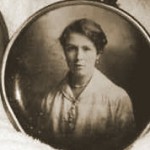 At one time genealogy only focused on the paternal line, following son to father and so on; with the singular focus of a constant surname followed through time. While the contribution of women to the continuation of the species was recognized, it was sadly neglected in terms of genealogical research.
At one time genealogy only focused on the paternal line, following son to father and so on; with the singular focus of a constant surname followed through time. While the contribution of women to the continuation of the species was recognized, it was sadly neglected in terms of genealogical research.
Following descent from the maternal line was considered to be of little account. Thankfully, those days are gone.
The Biggest Family Tree
Researching maternal lines is every bit as rewarding, important and deserving of recognition, it is after all half of your heritage.
Nothing makes this point more clear than the amazing research done by National Geographic and IBM on the Genographic Project. A study that began much the same way as any family tree project does. With the question, where do we come from? Of course, the question in this case is directed towards the human species as a whole.
The project, which focuses on tracing the migration, patterns of man from our earliest origins does it through the use of Mitochondrial DNA. DNA that can only be passed on from mother to child. Therefore, when it comes to the biggest family tree project of all it looks like the maternal line is finally getting the respect it deserves.
Genealogy Records for Women
In truth, more and more researchers are taking an interest in tracing their maternal roots. While researching female ancestors is rewarding it is also challenging, as women were virtually invisible in terms of leaving a paper trail.
Women did not:
- Own property in their own names
- Pay taxes
- Sign their names to legal documents
- Register to vote.
All these documents commonly used to trace male ancestors are of little use when hunting our elusive matriarchs. Despite this, our female ancestors did have records that were specific to women such as family bibles and diaries; additionally, they were registered either civilly or in a church at birth or baptism, marriage and death and they were recorded in the census. The main thing you need to know about researching your maternal line(s) is that it comes down to following an ever-changing trail of maiden names.
To take the tutorial “Tracing your female Ancestors: Documents and Research Techniques” join us on the Genealogy in General forum.
Image Credit: Ramona Hartley
Genealogy: Crests, Coat of Arms and Surname Origins?
February 24, 2012 by ramona
Filed under Articles, Genealogy and Surnames, Introduction to Genealogy, Latest News, Lesson 5 Articles
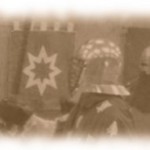
Have you ever searched for your surname in Google and come across websites for Family Crests, Coat of Arms and Surname Origins? If you are a genealogy beginner, you may even have gone to the website for information on your ancestors.
The real question here is how much value do these types of websites offer as a reliable source of information for your family tree research?
Surname origin websites, although highly entertaining and interesting, rarely have the information you really need. Many of them sell pre-written generic genealogies based on surname origin. Sadly, these genealogies often have nothing to do with sound family tree research and they can be misleading to those new to genealogy.
Surname Origins
For our first example, let us look at surname origin or surname history sites. Using the name Clegg in a Google search and randomly picking three sites, I find the following.
- The first site states that the Clegg surname “makes an impressive claim to being one of the oldest Anglo-Saxon surnames on record”. Then goes on to say the origins for the name hail from the “Rhine valley as far north east as Denmark”
- The second site surmises the Clegg surname is of English origin and comes from the Old Norse word “Kleggi” meaning at the foot of Owl Hill.
- A third surname origin website tells us that Clegg is an anglicized version of the Gaelic name “Mac Liaig(h)” which evolved into “Claque” and from there to Clegg. This site tells us that the name originates on the Isle of Mann.
From the above examples it is easy to see that while there may be a great deal of research and at least a grain of truth to each example, ultimately the information is contradictory and confusing. Therefore, while we all would like to know the origin of our family names Genealogy Beginner advises that it is best to regard these types of genealogy websites with a wee bit of skepticism.
Family Crests and Coat of Arms
Crests
A family crest historically is part of a family Coat of Arms or heraldry. It is called a crest because it was mounted on the top of a helm above the shield on a Coat of Arms. By the 13th century, a crest was used as a means of identification in tourney (think the movie – A Knights Tale) or on the battlefield.
Coat of Arms
A Coat of Arms also began as a way to identify an individual on the battlefield. Coat of Arms literally gets its name from a coat worn over armor or chain mail and was used initially to protect the armor or keep it cool under the hot sun during the crusades. Later it was decorated with identifying colors and designs in order to help distinguish friend from foe.
Ultimately a Coat of Arms is:
- An Armorial right that must be granted under due authority
- Usually the Crown or State
- Some governments (Canada) have the authority to grant the right.
Alternately, the right to bear arms can come from decent or “by virtue of ancestral right”.
What all this really means is that a coat of arms belongs to a direct family line and any website that tries to sell you your Coats of Arms is selling you a generic product that may or may not have anything to do with your lineage.
Overall, there is no real harm in surname origin or Coat or Arms websites so long as you are not misled into believing that they are an authority on your individual family tree. If you really want to know the origin of your surname (or whether or not there is a Coat of Arms associated with it) you will have to put the hard work into tracing your family tree as far back as you can, using well-established genealogy research techniques.
For more information on surname research, check out Genealogy Beginners Lesson Five: What’s in a Name?
Image Credit: Ramona Hartley
FamilySearch.org Announces Huge Website Changes
February 22, 2012 by ramona
Filed under Articles, Latest News

A post February 22, 2012 on the FamilySearch.org website announces big changes to its website. The changes are reported to include some significant new search features for its over 2.5 billion freely accessible records. The transformation comes in an effort to give users a more streamlined genealogy research experience by including all products, services and content on the same site.
Family Tree Search Improvements
In a nutshell, the benefits to users come down to greater convenience and improved accuracy of searches.
There will be:
New Features for Genealogists
In addition to these improvements there are some exciting new changes involving the search function. You will now be able to conduct single page searches of the databases and historic records. Search with new ways to customize your search fields. Use a “World Map” to locate local family history centers and detailed guides to help you navigate through all of the changes, including a wonderful video explaining how to use the new features.
Saying Goodbye to the Old Family History Site
Family Search wants you to know that the old website will be closed in the following months in order for them to concentrate all efforts on current and future improvements. The whole of their records have already been moved to the new site along with the new collections and improved features.
For links to FamilySearch.org’s new guides along with the site use instructional video, join us in the Genealogy News and Events Forum.
Image Credit: Flizia via Photobucket
Genealogy Webinars for Genealogy Beginners
February 19, 2012 by ramona
Filed under Articles, Genealogy Research Resources, Latest News, Sharing Genealogy Information
Genealogy we binars are becoming a popular way to stay up to date with the latest genealogy news and events. They are also a great resource for genealogy beginners to learn some new research tricks and tips.
binars are becoming a popular way to stay up to date with the latest genealogy news and events. They are also a great resource for genealogy beginners to learn some new research tricks and tips.
A genealogy webinar is a live interactive class, lecture or interview that is broadcast at a scheduled time over the internet. They can be a great way to hear about new developments and family tree resources or just to hear expert genealogists give a lecture on your favorite genealogy subjects.
While some genealogy webinars are free, some have a nominal fee. However, it is a good deal less expensive than travelling to a family history workshop and paying to hear the lecture live.
How Do Genealogy Webinars Work?
A lot goes into producing a good genealogy webinar.
Usually they are:
- Produced by a sponsor (generally the organizer of the webinar)
- Presented by a host who introduces the key speakers or guests and screens calls
- Attended by genealogy novices, hobbyists and professionals from their homes via computer
How Do I Attend A Genealogy Webinar?
Attending a genealogy webinar is simple; all you need is a computer with a high-speed internet connection and speakers. If you want to ask questions, a USB headset is recommended however, you can use a telephone. Most importantly, you will need to preregister, as you may have to download software to participate. Downloading the software is quick, free, and anti virus protection is included. It really is very easy and instructions for download are given when you preregister.
How Do I Find Genealogy Webinars?
You can find genealogy webinars in many places on the internet. Nevertheless, Genealogy Beginner has found that the best resource is at Genea Webinars blog. One of the reasons we think they are so wonderful is for their calendar of upcoming webinars. Another reason they are a favorite is that they have an archive of webinars. So, if you missed one you can still access it for ten days after it airs. This is perfect if you have a schedule conflict. One of the biggest reasons we love Genea Webinars is because most archived webinars are free.
Here is a sneak peek into some of Gena Webinars upcoming shows:
- Are You Ready for the 1940 U.S. Census Images with Thomas MacEntee, March 7
- The Pursuit from Genealogy Hobbyist to Professional with John Kitzmiller and Claire Brison-Banks, April 4.
- Reverse Genealogy: Finding the Living with Megan Smolenyak, April 25.
- DNA Research for Genealogists: Beyond the Basics with Ugo Perego. March 21.
- What is a ‘Reasonably Exhaustive Search’? with Michael Hait. September 12.
Genealogy Beginners Top Three Picks for Archived Webinars:
- Digital Books and Sites for Genealogists
- The Power of DNA in Unlocking Family Relationships
- Organize, Share, and Publish Your Digital Photos with Heritage Collector Suite
Genealogy Webinars are a good resource for genealogists no matter what your level of experience. If you are planning to attend a webinar for the first time and you need to learn a little more, join us on the Discovery Panel forums, where you will also find a link to Genea Webinars calendar and archives.
Image Credit: Roundpegbiz via Photobucket
Publishing Your Family History Book
February 18, 2012 by ramona
Filed under Articles, Family History, Latest News, Preserving Your Family Tree
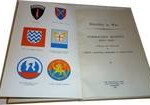 Early in January, our facebook friends told Genealogy Beginner about the exciting genealogy projects you had planned for 2012. Top among your projects was publishing your family history book.
Early in January, our facebook friends told Genealogy Beginner about the exciting genealogy projects you had planned for 2012. Top among your projects was publishing your family history book.
Genealogy Beginner thinks publishing your family history is an outstanding goal and we want to support you in your efforts. With that in mind, here is some information that will bring you closer to reaching it.
Publishing your family history book is a big step. There is more to it than simply sending it to the printer. Before you get to that place, you need to consider a couple of important points.
Copyright
Copyright your book! Even though, under the Berne Convention you automatically own copyright. Copyrighting your book it will guarantee your intellectual property rights and protect your from copyright infringement. If you are thinking that it sounds like a bit of a hassle, do not worry copyright it is a lot easier than you may have imagined.
In order to copyright, your book you will need to send three items in to the office where you wish to register.
The fees will depend on the office (country specific), to which you are sending them and it is important that you send all items in the same envelope. There are several offices and a quick Google search will point them out to you.
Do you know your options when it comes to publishing?
You have several options when it comes to publishing your family history book. Genealogy Beginner recommends the following two choices.
Self Publish
Self-publishing is probably your best choice if your book is for yourself. Self-publishing is as easy as printing out at home or sending your work in to a local printer. If you plan to print out at home, three ring binders work well for expanding your work later. However, having your work professionally printed will give you the option of having the printer do the binding.
Work with an On-Demand publisher.
On-demand publishing is a great choice if you want to offer your book for sale, either to the public or within your family. Probably the greatest benefit to on-demand publishing is that it is very budget friendly as there are no up-front costs to you.
Of course, you can choose to go with a commercial publisher or look into offering your family history book as an eBook. It will all depend on your objective.
For a list of On-demand publishers, join us on the forum “Genealogy in General”. If you have already published your family history book Genealogy Beginner wants to know about it. Stop by, join the discussion and share some tips with other genealogy beginners.
Image Credit: Inkyphoto via Photobucket
“Who Do You Think You Are”, Episodes 1 & 2: Family Lore
February 16, 2012 by ramona
Filed under Articles, Genealogy Military Records, Genealogy Records 101, Latest News
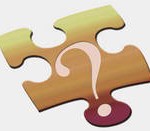 “Who Do You Think You Are” begins each episode by saying “To know who you are, you have to know where your story began”. Those words could not ring truer than in the first two episodes of season three.
“Who Do You Think You Are” begins each episode by saying “To know who you are, you have to know where your story began”. Those words could not ring truer than in the first two episodes of season three.
Episode One: Martin Sheen
With a colorful history of his own, Mr. Sheen has made headlines for his efforts as a civil activist supporting issues from liberal politics to environmental concerns. It was hardly a surprise to learn that his passionate outspoken nature may stem from ancestral roots on both sides of his family.
Mr. Sheen begins his genealogy journey with a little family lore. The subject of this family tree investigation is Michael Phelan, an uncle on his mother’s side, who was reportedly a volunteer in the Irish Republican Army.
To help Mr. Sheen uncover the truth behind the family tale, “Who Do You Think You Are” applies a number of research methods and utilizes all relevant resources.
In the first part of this episode, we see genealogical research conducted through an examination of:
The discoveries made during this systematic process uncovered an unexpected truth. For years, Mr. Sheen’s family had believed that their legendary ancestor fought on the side of the IRA. However, his visit to the Military Archives revealed that Michael Phelan actually fought for the opposing side…the Irish National Army.
Episode Two: Marisa Tomei
Marisa Tomei was the guest on the second episode of “Who Do You think You Are” season three. In this episode family lore also plays a big part in the Tomei family’s desire to dig in to their past.
The subject of the story is Marisa’s Great Grandfather Leopoldo, who was murdered for uncertain reasons. Family legend hints that the murder was motivated by a possible love affair or a debt he owed, shedding an unflattering light on this notorious ancestor.
As the Tomei story unfolds, “Who Do You Think You Are” takes us on a trip to Italy where Marisa wades through a maze of documents, research resources and consultations with experts who help her to examine:
However, before she leaves Marissa visits her mother who has uses a well know genealogy database to make a family tree.
Perhaps one of the most enjoyable components of family tree research is the family history aspect. Learning the truth behind stories passed from generation to generation. Often these stories have a grain of truth, rarely is it ever the whole truth as we see in the first two episodes of season three.
If you missed this episode of “Who Do You Think You Are”, join us in the forum The Discovery Panel for a link to where you can watch the episode online free. You didn’t think I was going to ruin the ending did you? Also, join us for a genealogy research tip based on the first two episodes.
Image Credit: Rav 7 Via Photobucket
Genealogy TV Favorites
February 14, 2012 by ramona
Filed under Articles, Genealogy Research Resources, General Tips, Latest News, Sharing Genealogy Information
 With the new season of NBC’s Who Do You Think You Are now regularly scheduled for Friday nights 7/8c and the BBC program Finding Your Roots set to air on March 25, it may seem that genealogy addicts would be getting their family history fix.
With the new season of NBC’s Who Do You Think You Are now regularly scheduled for Friday nights 7/8c and the BBC program Finding Your Roots set to air on March 25, it may seem that genealogy addicts would be getting their family history fix.
However, if you just cannot get enough, there are a number of excellent programs that will help tide you over. Some of them may be your old favorites, while you can enjoy others as new-to-you.
Genealogy TV Timeline
Genealogy TV may have gained fame with the Who Do You Think You Are franchise but it was not the first of its kind. From genealogy TV’s beginnings genealogy beginner plots a timeline of genealogy viewing pleasure.
History Detectives – PBS: Premier 2003
History Detectives a PBS documentary series had a unique approach to genealogy. The show centered on solving the mysteries of family heirlooms and historic objects through family history and genealogy.
Who Do You Think You Are – BBC: Premier 2004
The first of the WDYTYA franchise began with the British version and was a huge success right from the start. Expanding to produce shows for Canadian (2007), Australian (2008), Irish (2008) and US (2010) audiences, it is still going strong.
Ancestors in the Attic – History Channel: Premier 2006
History Channel had its contribution to Family Tree broadcasting with the unforgettable Canadian program Ancestors in the Attic. The premise of this series follows a team of genealogists as they use traditional research techniques combined with genealogy DNA research to present an entertaining picture of genealogist as detectives.
Coming Home – BBC: Premier 2007
Coming home is a charming program that focuses on Welsh genealogy. Produced by BBC Wales it follows a similar format to Who Do You Think You Are. Each episode features a celebrity in search of their Welsh roots.
The Genealogy Roadshow – RTE One: Premier 2011
A four part Irish Genealogy TV series airs on RTE One. This program follows a fun format much like Antiques Roadshow. The Ancestor hunters of the Genealogy Road Show travel Ireland solving family history mysteries.
Faces of America – PBS: Premier 2010
Faces of America the four part series hosted by professor Henry Louis Gates is another enjoyable PBS program. Faces of America combines DNA testing with genealogy research to delve into the family trees of celebrities.
The great news is that you do not have to wait a week to watch more genealogy TV as episodes of for these must watch shows are available now…online free. Join us on the Coffee Shop Forum for links.
Image Credit: FrankAllan via Photobucket
What is a Resident Genealogist?
February 10, 2012 by ramona
Filed under Articles, General Tips, Getting Started in Genealogy, Introduction to Genealogy, Latest News
 A resident genealogist is a professional on staff at a library, archives or even on a genealogy website who is there to provide family tree research advice and guidance, particularly to genealogy beginners. A quick question to the resident genealogist may save you time as well as a great deal of frustration and it can be a lot of fun.
A resident genealogist is a professional on staff at a library, archives or even on a genealogy website who is there to provide family tree research advice and guidance, particularly to genealogy beginners. A quick question to the resident genealogist may save you time as well as a great deal of frustration and it can be a lot of fun.
If nothing else your Genealogist in Residence is almost certainly, part detective and part historian. A website with a resident genealogist is showing you how much they care about you, their members and how important it is to them to help you in every way they can.
What Does a Resident Genealogist Do?
A resident genealogist:
- Searches out new genealogy resources
- Provides educational materials
- Writes articles about genealogy
- Answers questions about family tree research
- Can help genealogy beginners to understand genealogical documents
- Provides tips and inspiration to keep you motivated
The primary duty of a resident genealogist is to help you learn to conduct your own genealogy research.
How can a Resident Genealogist Help Me?
When you have hit a brick wall a resident genealogist can help you find more resources or make suggestions on where to look next. If you are having a difficult time understanding your ancestor’s birth, marriage or death certificate, a resident genealogist is always happy to help. Any problem you come across is like candy to a resident genealogist, so do not be shy about asking.
What Kind of Questions can I ask?
You can ask any questions you need; no question is too big or too small. When asking your question include the details, give the names dates and places of the ancestor you need help with. State why reading a particular document is a problem, is the writing is too faded or messy. Want to know what a third cousin twice removed is or what all those numbers on a Family Tree form mean…just ask!
Genealogy Beginner encourages you to go to our resident genealogist with your questions. You can usually find her on the Ask a Genealogist forum or on our Facebook page.
Image Credit: dbickert via Photobucket

